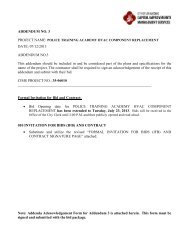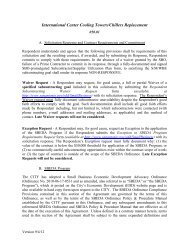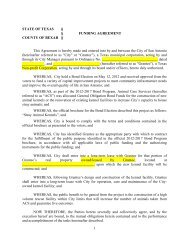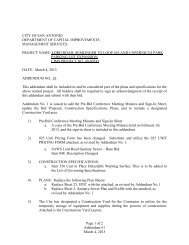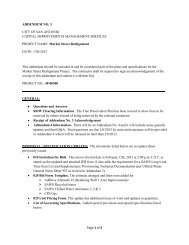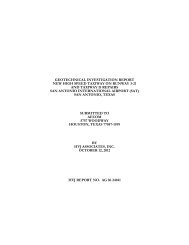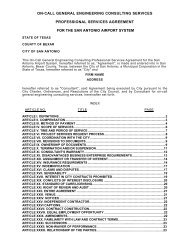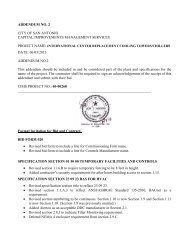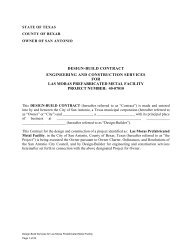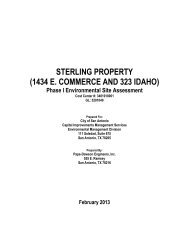Programming Documents for Pre-K for SA - The City of San Antonio
Programming Documents for Pre-K for SA - The City of San Antonio
Programming Documents for Pre-K for SA - The City of San Antonio
You also want an ePaper? Increase the reach of your titles
YUMPU automatically turns print PDFs into web optimized ePapers that Google loves.
from flowing into the conduit. Conduits shall be reamed and installed with bushings, which will<br />
mitigate sheath damage when pulling cable(s).<br />
Where several large backbone cables are passing vertically through the room, a vertical cable<br />
tray or other suitable vertical attachment should be appropriately positioned to support the<br />
cables. When a cable tray is used, the cables should be secured to the cable tray in an orderly<br />
fashion to ensure that they are properly supported and the entire weight <strong>of</strong> the cable is equally<br />
distributed over several cable tray rung supports.<br />
8.2.4.5 Bonding and Grounding Conduits<br />
Conduits shall be bonded to the equipment grounding system. Conduits shall be bonded to<br />
either the telecommunications main grounding busbar (TMGB) or to a telecommunications<br />
grounding busbar (TGB) where present.<br />
Grounding bushings are typically installed on the end <strong>of</strong> the conduit. For electrical metallic<br />
tubing (EMT), a set-screw fitting is placed on the end <strong>of</strong> the conduit and the grounding bushing<br />
screwed on to the fitting and tightened using the appropriate tool. On intermediate metal<br />
conduit (IMC) and rigid metal conduit (RMC), a grounding bushing may be screwed onto the<br />
threaded end <strong>of</strong> the conduit and tightened until secure. A threadless grounding bushing,<br />
installed with set screws, is also available which can provide an alternate means <strong>for</strong> locating the<br />
ground lug.<br />
In a TR or ER, each conduit can be attached to the channel stock with a conduit strap. A single<br />
conduit in each run <strong>of</strong> channel stock can be equipped with a grounding bushing. <strong>The</strong> entire<br />
section <strong>of</strong> channel stock can effectively be grounded using a single bushing and ground wire.<br />
An alternative method is to install a grounding connection onto the channel stock and then<br />
route the ground conductor to the nearest TMGB or TGB.<br />
Where a small number <strong>of</strong> conduits are installed, a grounding bushing should be installed at the<br />
end <strong>of</strong> each conduit <strong>for</strong> the attachment <strong>of</strong> a ground wire, which connects to the TMGB or TGB.<br />
Conduits in close proximity to each other can be bonded together and one <strong>of</strong> them will be<br />
bonded to the TMGB or TGB.<br />
8.2.4.6 Securing Conduit<br />
Conduits shall be secured to prevent movement.<br />
Throughout the conduit route, cross bracing may be used to stabilize the conduit(s), which will<br />
mitigate lateral movement during cable pulling operations. Stabilizing the conduits can be<br />
accomplished by the use <strong>of</strong> conduit straps, channel stock, or ATR placed at opposing angles<br />
(180 degrees opposite from each other). <strong>The</strong> same anchoring mechanisms can be used to secure<br />
the straps and cross braces as used to hang the conduits from the building structure.<br />
When terminating conduits at a plywood backboard (e.g., in a telecommunications room), they<br />
should be secured to the top <strong>of</strong> the plywood backboard or just above the backboard when<br />
entering from overhead. Securing and terminating conduits above the plywood backboard<br />
allows <strong>for</strong> full usage <strong>of</strong> the plywood backboard <strong>for</strong> termination and routing <strong>of</strong> cabling. Channel<br />
stock may be used to attach the conduits to the room wall.<br />
36



